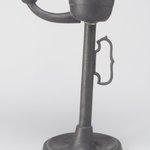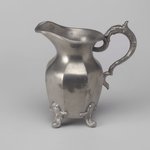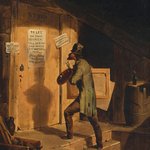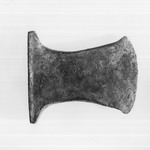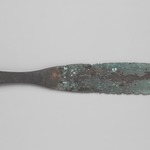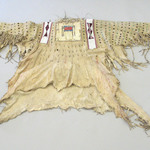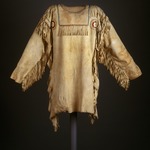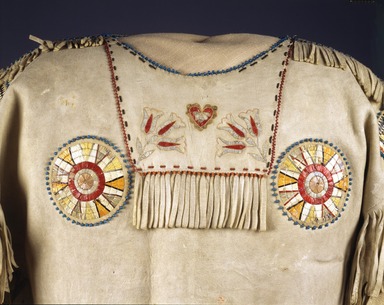

Red River Metis. Chief's War Shirt, 19th century. Buckskin, porcupine quills, garnet beads, pony beads, seed beads, thread , 39 in. (99.1 cm). Brooklyn Museum, Henry L. Batterman Fund and Frank Sherman Benson Fund, 50.67.4. Creative Commons-BY (Photo: Brooklyn Museum, 50.67.4_front_SL4.jpg)
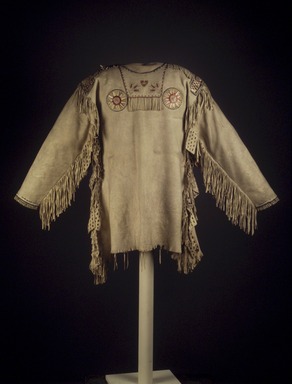
Red River Metis. Chief's War Shirt, 19th century. Buckskin, porcupine quills, garnet beads, pony beads, seed beads, thread , 39 in. (99.1 cm). Brooklyn Museum, Henry L. Batterman Fund and Frank Sherman Benson Fund, 50.67.4. Creative Commons-BY (Photo: Brooklyn Museum, 50.67.4.jpg)
Chief's War Shirt
Arts of the Americas
This shirt may have been made for trade, because it has no embellishments that identify a specific warrior owner.
The woman who made it was proficient in many techniques. The bib is delicately embroidered with rays of traditional porcupine quills. On the bodice a two-pony-bead edging technique is used, with blue beads on the top and red garnet beads on the sides. Pony beads are so called because they were brought in by traders in the packs of ponies. The shoulder seam coverings were finely woven on a loom. Hanging tabs along the side and sleeves show pierced decorations.
The woman who made it was proficient in many techniques. The bib is delicately embroidered with rays of traditional porcupine quills. On the bodice a two-pony-bead edging technique is used, with blue beads on the top and red garnet beads on the sides. Pony beads are so called because they were brought in by traders in the packs of ponies. The shoulder seam coverings were finely woven on a loom. Hanging tabs along the side and sleeves show pierced decorations.
MEDIUM
Buckskin, porcupine quills, garnet beads, pony beads, seed beads, thread
DATES
19th century
DIMENSIONS
39 in. (99.1 cm)
Floor to top of mannequin- 56 ½ “
Base of mannequin 12 x 12”
Shirt on the mannequin
Front 40 “ long
Back 39” long
Width of the shirt on the mannequin across the front with the arms at a slight angle as they are now- 36”
Shoulder width across the front- 24 1/2”
Front to the back width on the side is 16”
Length of sleeves 2 (show scale)



COLLECTIONS
Arts of the Americas
ACCESSION NUMBER
50.67.4
CREDIT LINE
Henry L. Batterman Fund and Frank Sherman Benson Fund
PROVENANCE
Prior to 1848, provenance not yet documented; by 1848, acquired by Nathan Sturges Jarvis; 1848, gift of Nathan Sturges Jarvis to the New-York Historical Society, New York, NY; 1937, loaned by the New-York Historical Society to the Brooklyn Museum; 1950, purchased from the New-York Historical Society by the Brooklyn Museum.
Provenance FAQ
CATALOGUE DESCRIPTION
Man's shirt decorated with beads and quillwork executed in several techniques. The bib has a heart and two flower sprays in red, green, and blue porcupine quills. The top edge is decorated with blue pony beads in a two-bead edging technique: red garnet beads were applied along the sides with the same technique. An inner broken line border of small red and black seed beads are also sewn on the bib. Two “rays" or "spokes". The inner ring, now grey, is surrounded by a ring of light blue which is then encircled by a red ring. The radiant rays are filled with areas quilled in pale yellow, light blue, and orange. Each entire rosette is encircled at the seam by large blue pony beads.
The shoulder seam "coverings" were finely woven on a loom, but are now very deteriorated. A geometric pattern of red and blue "Xs", interspersed with red and blue diamonds are edged with small squares in red, black, and blue. The shoulder strips are checkered, quilled with three lines of colored squares in orange, blue, purple, black, yellow and white and finished along the sides with a zigzag pattern. The seam ornaments and shoulder strips are both edged with a single line of the blue pony beads.
Tabs along each side and along the sleeves have pierced decoration. The "cuffs" are ornamented with two lines of blue pony beads. First, a single line and then a double line closer to the opening. The side seams and sleeves have long fringes, but very tiny fringes at the wrist, with every other one wrapped with orange quills.
The comparatively simple decoration and unwrapped fringe are possibly due to the fact the shirt produced exclusively for sale and so rated less decoration.
See Jarvis report in Arts of Americas' files.
EXHIBITIONS
MUSEUM LOCATION
This item is not on view
CAPTION
Red River Metis. Chief's War Shirt, 19th century. Buckskin, porcupine quills, garnet beads, pony beads, seed beads, thread
, 39 in. (99.1 cm). Brooklyn Museum, Henry L. Batterman Fund and Frank Sherman Benson Fund, 50.67.4. Creative Commons-BY (Photo: Brooklyn Museum, 50.67.4_front_SL4.jpg)
IMAGE
front, 50.67.4_front_SL4.jpg. Brooklyn Museum photograph, 2014
"CUR" at the beginning of an image file name means that the image was created by a curatorial staff member. These study images may be digital point-and-shoot photographs, when we don\'t yet have high-quality studio photography, or they may be scans of older negatives, slides, or photographic prints, providing historical documentation of the object.
RIGHTS STATEMENT
Creative Commons-BY
You may download and use Brooklyn Museum images of this three-dimensional work in accordance with a Creative Commons license. Fair use, as understood under the United States Copyright Act, may also apply.
Please include caption information from this page and credit the Brooklyn Museum. If you need a high resolution file, please fill out our online application form (charges apply).
For further information about copyright, we recommend resources at the United States Library of Congress, Cornell University, Copyright and Cultural Institutions: Guidelines for U.S. Libraries, Archives, and Museums, and Copyright Watch.
For more information about the Museum's rights project, including how rights types are assigned, please see our blog posts on copyright.
If you have any information regarding this work and rights to it, please contact copyright@brooklynmuseum.org.
RECORD COMPLETENESS
Not every record you will find here is complete. More information is available for some works than for others, and some entries have been updated more recently. Records are frequently reviewed and revised, and we welcome any additional information you might have.








